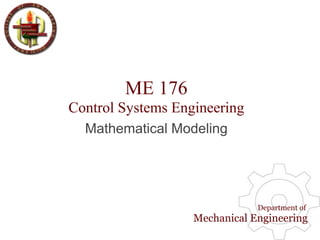Report
Share

Recommended
Recommended
More Related Content
What's hot
What's hot (20)
state space representation,State Space Model Controllability and Observabilit...

state space representation,State Space Model Controllability and Observabilit...
SERIES SOLUTION OF ORDINARY DIFFERENTIALL EQUATION

SERIES SOLUTION OF ORDINARY DIFFERENTIALL EQUATION
APPLICATION OF HIGHER ORDER DIFFERENTIAL EQUATIONS

APPLICATION OF HIGHER ORDER DIFFERENTIAL EQUATIONS
Viewers also liked
Mathematical Modelling Continuous Stirred Tank Reactor Systems (CSTR)Class 10 mathematical modeling of continuous stirred tank reactor systems (...

Class 10 mathematical modeling of continuous stirred tank reactor systems (...Manipal Institute of Technology
Viewers also liked (9)
Modern Control - Lec 02 - Mathematical Modeling of Systems

Modern Control - Lec 02 - Mathematical Modeling of Systems
Class 10 mathematical modeling of continuous stirred tank reactor systems (...

Class 10 mathematical modeling of continuous stirred tank reactor systems (...
Class 7 mathematical modeling of liquid-level systems

Class 7 mathematical modeling of liquid-level systems
Similar to Lecture 2 ME 176 2 Mathematical Modeling
Similar to Lecture 2 ME 176 2 Mathematical Modeling (20)
Transfer function, determination of transfer function in mechanical and elect...

Transfer function, determination of transfer function in mechanical and elect...
4. Analogy between electrical and mechanical systems.pptx

4. Analogy between electrical and mechanical systems.pptx
Control system introduction for different application

Control system introduction for different application
EE380-4 Course project Experimental determination of a Ser.docx

EE380-4 Course project Experimental determination of a Ser.docx
MODELLING, ANALYSIS AND SIMULATION OF DYNAMIC SYSTEMS USING CONTROL TECHNIQUE...

MODELLING, ANALYSIS AND SIMULATION OF DYNAMIC SYSTEMS USING CONTROL TECHNIQUE...
More from Leonides De Ocampo
More from Leonides De Ocampo (15)
Lecture 2 ME 176 2 Mathematical Modeling
- 1. ME 176 Control Systems Engineering Department of Mechanical Engineering Mathematical Modeling
- 2. Mathematical Modeling: Introduction Mathematical Models are representation of a system's schematics, which in turn is a representation of a system simplified using assumptions in order to keep the model manageable and still an approximation of reality. 1. Transfer Functions (Frequency Domain) 2. State Equations (Time Domain) First step in creating a mathematical model is applying the fundamental laws of physics and engineering: Electrical Networks - Ohm's law and Kirchhoff's laws Mechanical Systems - Newton's laws. Department of Mechanical Engineering
- 3. Mathematical Modeling: Transfer Functions Differential Equation Representation: Transfer Function : - Distinct and Separate - Cascaded Interconnection Department of Mechanical Engineering
- 4. Mathematical Modeling: Laplace Transform Represents relations of subsystems as separate entities. Interrelationship are algebraic. Laplace Transform: Inverse Laplace Transform: Department of Mechanical Engineering
- 5. Mathematical Modeling: Laplace Transform Department of Mechanical Engineering Laplace Transform Table Unit Impulse Unit Step Ramp Exponential Decay Sine Cosine Laplace Transform Theorems Linearity Frequency Shift Time Shift Scaling Differentiation Integration Initial Value Final Value
- 6. Mathematical Modeling: Laplace Transform Partial Fraction Expansion, where roots of the Denominator of F(s) are: Note: N(s) must be less order that D(s) . 1. Real and Distinct where, Department of Mechanical Engineering
- 7. Mathematical Modeling: Laplace Transform Partial Fraction Expansion, where roots of the Denominator of F(s) are: 2. Real and Repeated where, Department of Mechanical Engineering
- 8. Mathematical Modeling: Laplace Transform Partial Fraction Expansion, where roots of the Denominator of F(s) are: 3. Complex or Imaginary (Part 1) - compute for residues Steps: a. Solve for known residues. b. Multiply by lowest common denominator and clearing fractions. c. Balancing coefficients. Department of Mechanical Engineering
- 9. Mathematical Modeling: Laplace Transform Partial Fraction Expansion, where roots of the Denominator of F(s) are: 3. Complex or Imaginary (Part 2) - put into proper form Steps: a. Complete squares of denominator. b. Adjust numerator. Department of Mechanical Engineering
- 10. Mathematical Modeling: Transfer Functions c(t) - Output r(t) - Input Systems that can be represented by linear time invariant differential equations. Initial conditions are assumed to be zero . Permits interconnections of physical systems which can be algebraically manipulated. Department of Mechanical Engineering
- 11. Mathematical Modeling: Transfer Functions Department of Mechanical Engineering
